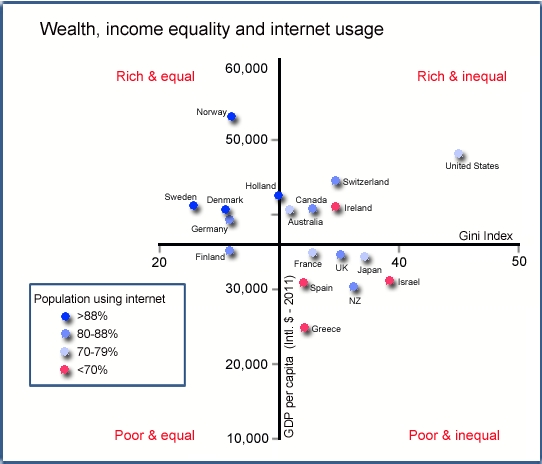By the numbers: equal and connected?

The lack of access to high-speed broadband has often been cited as one of the reasons why Australia is so far down the league table of internet users. Compare, for example, the 76 per cent of Aussies who use the internet (according to 2011 World Bank data) to usage levels in northern Europe: Iceland (96 per cent), Norway (93 per cent), the Netherlands (91 per cent), Luxembourg (90 per cent) and Sweden (90 per cent). Why are these countries so far ahead? Cold winters and dark nights might be part of the answer, but I suspect that there's another factor at play here.
Economic health is certainly another part of the equation, but it's not the sole reason, either; Norway is ahead of the pack when it comes to GDP per capita, but the other countries mentioned fall well behind the US. And yet, internet usage in the US is at just 74 per cent.
Let's look at another indicator: the Gini Index is used to compare income inequality within a country; the higher the figure, the greater the inequality. Iceland's Gini Index is just 28, and all the Scandinavian countries have a rating in the 20s. In the United States, the figure is 45, which is not far behind countries like Thailand, Uganda and Costa Rica.

Look at the graph: one would expect, given the relatively high GDP of the US, that internet penetration would be high. Now look at the high Gini Index score; it stands to reason, doesn't it? If a significant segment of the population is struggling financially, they won't be able to afford to pay internet fees.
The diagram also shows how Australia's internet penetration is lower than you'd expect. We have an income per capita and Gini index on par with Canada and Holland. Despite that, internet usage is much lower here (76 per cent), compared to Canada (81 per cent) and Holland (91 per cent). So, perhaps infrastructure is the inhibiting factor here. When that gap is bridged, hopefully take-up will increase to be on a par with both of these nations. That would be a big step forwards for our local digital economy.
It's a less rosy prospect for the US. While Australia's Gini Index is improving (from 35.2 in 1994 to 30.5 in 2006), the US is getting worse (from 40.8 in 1997 to 45 in 2007). If a widening rich-poor gap is inhibiting internet take-up, could that result in even greater income separation? The internet, it's often said, levels the playing field — but only for those who use it.